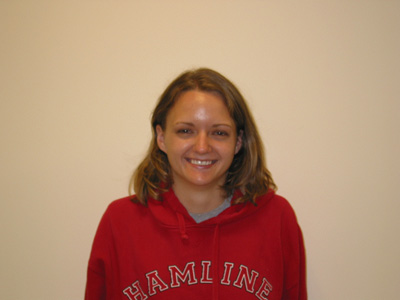
Home Institution: Hamline
Major/Minor:
MRSEC Mentor: Mike Ward
The Design and Synthesis of Oligothiophene Substituted Semiconductors
The objective of this research project is the synthesis of organic molecules that will crystallize into packing motifs considered optimal for high performance in thin film field effect transistors (FETs). The primary synthetic targets will be oligothiophenes equipped with phenyl substituents at the termini that serve as "molecular clamps" capable of optimizing p-p overlap of oligothiophene cores in the crystalline state. Single crystals of these targets will be characterized by X-ray diffraction to elucidate the role of the molecular clamps in crystal packing. Materials for mobility measurements will be identified based on important crystal attributes, including small interplanar separations between the oligothiophene cores and a propensity to form plate-like crystal habits that will naturally form thin film morphologies on the FET platform.
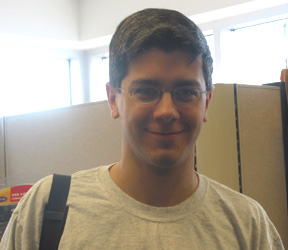
Home Institution: MIT
Major/Minor:
MRSEC Mentor: Marc Hillmyer
Wettable Nanoporous Polymer Monoliths
Nanoporous polystyrene monoliths monoliths have been prepared from polystyrene-polylactide block copolymers (PS-b-PLA) that form hexagonally packed nanocylinders of PLA in a PS matrix. The ability to uptake methanol into these pores has been demonstrated in previous publication. Due to the hydrophobic nature of PS, the pores are not accessible to many aqueous solutions. In this work, hydrophilic polyethylene oxide (PEO) has been incorporated onto the pore walls of the nanocylinders via blending of PS-b-PLA with PS-b-PEO. Removal of the PLA via hydrolysis of the polyester bonds gives pores with the ability to uptake pure water.
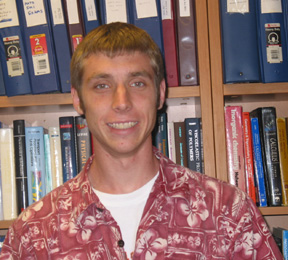
Home Institution: University of Kansas
Major/Minor:
MRSEC Mentor: Dan Frisbie
Spin-coated Thiophene Films on Silicon Wafers
During the first part of the summer, I will be conducting anPoly(3-hexylthiophene) (P3HT) is currently a leading candidate for use in organic field-effect transistors (FETs), due to its relatively high charge mobility and flexibility. It can be easily applied by spin-coating a solution onto the substrate. Our research focused on creating a suitable thin film of P3HT, building a FET with P3HT as the semiconducting layer, and attempting to incorporate gold nanoparticles into this layer.
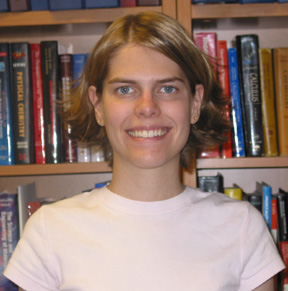
Home Institution: University of Illinois Urbana-Champaign
Major/Minor:
MRSEC Mentor: Chris Macosko
Effect of the Addition of Poly(isoprene-b-dimethylsiloxane) on the Interfacial Tension of Polyisoprene/Poly(dimethylsiloxane) Blends
The effect of poly(isoprene-b-dimethylsiloxane) on the inerfacial tension of an immiscible polymer blend of polyisoprene and poly(dimethylsiloxane) homopolymers was investigated. A PI drop will be added to a PDMS matrix containting P(I-b-DMS), in an attempt to simulate equilibrium between the PI and PDMS polymers. A spinning drop tensiometer will be used to calculate the interfacial tension as the concentration of block copolymer in the tertiary system is varied. It is expected that the interfacial tension will approach zero when the proper concentration of P(I-b-DMS) is added if the system is in pseudo-equilibrium state, assuming that the concentration of block copolymer is less than the critical micelle concentration.
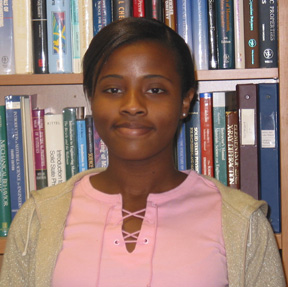
Home Institution: Florida A&M University
Major/Minor:
MRSEC Mentor: Victor Barocas
Generation and Evaluation of 3-D Collagen Fiber Network Models
The basis of many different types of tissues is formed by collagen fiber networks. Specific examples include tendons, skin, ligaments, cartilage, and fetal membranes. Artificial collagen networks are important as potential tissue replacements. In order to repair a damaged network or create an artificial network, we must first understand the structure. We will develop a computer program to evaluate the properties of the fiber networks and compare them to actual collagen gel networks. We will generate collagen fiber network models by various algorithms and determine which models best match the actual networks. The selected model can then be used as a standard for studying the properties of tissue equivalents.
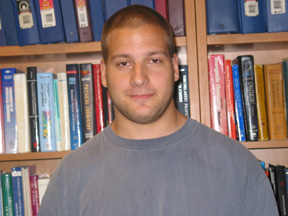
Home Institution: University of Connecticut
Major/Minor:
MRSEC Mentor: Frank Bates
Mechanical Testing of Shear Aligned PC/ PEE /PE Block Copolymer in the O52 Morphology
This research investigates the mechanical properties of a PC-PEE-PE block copolymer that microphase separates into the O52 network morphology. Copolymers are known to combine the mechanical properties of their homopolymers in a number of different ways. We combine glassy PC, semi-crystalline PE and PEE rubbery blocks. Anionic synthesis and subsequent hydrogenation produced PC-PEE-PE with composition of 0.25-0.5-0.25, respectively, as confirmed by light scattering and NMR. Dynamic mechanical analysis determined order-order and order-disorder transition temperatures. Samples were formed by hot pressing. These samples were shear-aligned under varying shear conditions, resulting in long-range order. Small angle x-ray scattering confirmed sample crystal structure and alignment. Tensile bars were cut and tested for each axis of the crystal unit cell.
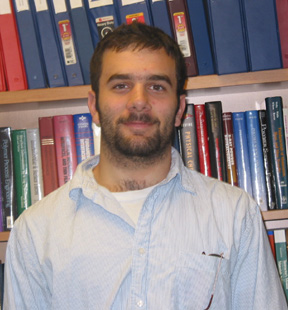
Home Institution: Macalester College
Major/Minor:
MRSEC Mentor: Chris Leighton
Dependence of Exchange Bias on Annealing Time in Ni50Mn50/Ni80Fe20 Thin Film Bilayers
Our research entailed investigating the hysteresis loop, exchange bias and coercivity as a function of annealing time and temperature in NiMn/NiFe, antiferromagnetic (AF)/ferromagnetic (F) bilayers. Bilayers such as these are used in the magnetic recording industry in "state-of-the-art" read heads. Annealing is required to transform the NiMn from the as-deposited non-magnetic face centered cubic (fcc) phase to the AF face centered tetragonal (fct) phase. We have discovered that a balance exists between annealing aggressively (to completely transform the fcc phase to fct) and restricting the growth of an interdiffused layer at the interface.

Home Institution: University of Missouri-Columbia
Major/Minor:
MRSEC Mentor: Mark Nicosia
Mechanical Properties of Isolated Porcine Esophageal Tissue
Fundamental understanding of the behavior of the muscle tissue in the esophagus can be a valuable and useful tool to determine better cures for such diseases as gastroesophageal reflux, i.e. heartburn. The goal of the research is to develop insight into the esophageal muscle mechanics. The esophagus is composed of ttwo distinct types of muscle: circular and longitudinal. These types of muscle tissue will be tested both separately and together using uniaxial and biaxial testing. The stretch of the muscle tissue on each axis will be closely monitored along with the load and displacement to determine the mechanical properties.
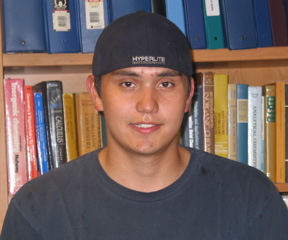
Home Institution: Augsburg College
Major/Minor:
MRSEC Mentor: Tim Lodge
Differential Scanning Calorimetery of Glassy Mixtures
The purpose of my research was to make polymer blends of various sorts and analyze them using a Differential Scanning Calorimeter (DSC). Several blends were made that ranged from solvent/solvent mixtures to high molecular weight polymer mixtures. These mixtures were made to help try and understand the relationship between two characteristics of the glass transition phase and the variation of molecular weight in these mixtures. The two aspects of the glass transition phase that we were looking at were the point of Tg and the width of the transition itself. The point of Tg is where the substance starts breaking apart, and loses its cohesive properties due to increase in kinetic energy.
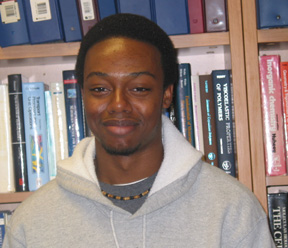
Home Institution: Florida A&M University
Major/Minor:
MRSEC Mentor: Dan Dalberg
Exchange anisotropy is an interfacial phenomenon resulting from the direct exchange coupling of a ferromagnet and an antiferromagnet. A basic understanding is lacking even though this exchange anisotropy has aided technological advancements in controlling magnetization in particular devices. We use Ta/Co samples grown on single crystal CoO oriented substrates by dc magnetron sputtering. We are attempting to use an alternative to the hysteresis loop technique while expecting to help lead to the enhancements of this phenomenon's use in science.
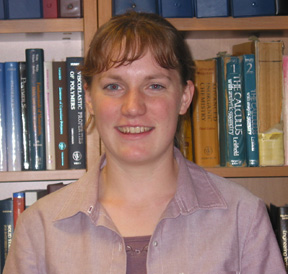
Home Institution:
Major/Minor:
MRSEC Mentor: Tim Lodge
Viscosity of Miscible Polymer Blends
A central issue in polymer blend dynamics is determining how to predict the fiscosity of blends given the viscosity of the individual polymers. Contrary to intuition, the blend viscosity is not simply the weighted average of the two components' viscosities. This research seeks to confirm or alter a recent model that makes blend viscosity predictions possible. For this research, a model miscible blend system of polystyrene (PS) and polyA(vinyl methyl ether) (PVME) will be used, because viscosity predictions show unusual behavior. Several PS/PVME blend systems should provide a wide range of viscosity values, measured over a range of temperatures and compositions.
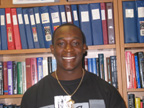
Home Institution: Florida A&M University
Major/Minor:
MRSEC Mentor: Dan Frisbie
Construction and Characterization of Organic Thin-Film Transistors
The possibilities of the creation of new products have led to significant interest in the use of organic materials as semiconductors. With this is mind, a high mobility (approximately 1 cm2/Vs) Thin Film Transistor will be constructed using an organic material (Pentacene) of exceptional electrical properties. The process will be completed using various methods of deposition, including thermal evaporation for the metal electrodes and organic semiconductor, as well as chemical vapor deposition for the dielectric. Also, these films will be structurally characterized using Atomic Force Microscopy & X-Ray Diffractometry and the semiconductor itself will be electrically characterized by taking current voltage measurements.
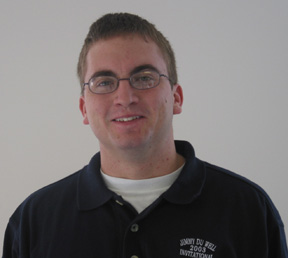
Home Institution: Florida Institute of Technology
Major/Minor:
MRSEC Mentor: Marc Hillmyer
Formation of a High Density Polyethylene-Polycyclooctene Block Copolymer
Many current biotechnological applications require mechanically anisotropic materials. That is, the material should be flexible in one direction, yet rigid in the other. However, these properties are rarely found in a single material. Therefore, combinations of materials with varied properties are used, consequently increasing the manufacturing cost and size of the device. One possible path to anisotropic behavior in a single material is to form a block copolymer of polycyclohexylethylene (PCHE) and polyethylene (PE). Using ring opening metathesis polymerization (ROMP), a polycyclooctene (PCOE) block can be inserted in the center of a double bond-functionalized polystyrene (PS) chain in the presence of the second generation Grubbs catalyst to form a triblock. After hydrogenation of PS and PCOE, the block copolymer consists of PCHE and PE. It is critical that the PE section is extremely linear, which increases the crystallinity of the material and is expected to enhance its anisotropy. ROMP of cyclooctene is the projected path we will take to achieve this.

Home Institution: Florida A&M University
Major/Minor:
MRSEC Mentor: Lee Penn
Investigation of TiO2 Nanoparticles and their Monodispersity
The purpose of this study is to develop a synthesis that produces monodisperse TiO2 particles similar in both size and shape. Monodispersity, a size distribution where the variation is less than 5% rms of the average diameter, is key due to the particles' ability to form in different sizes and shapes. Once accomplished, the particles' impurity level and phase will be examined through the use of X-ray diffraction (XRD). XRD will be used to identify and quantify the phase and crystallite size of the synthesized TiO2 particles. In addition, TEM will be used to determine particle sizes, growth mechanisms, atomic structure, particle morphologies, crystallography, and defect types and locations.

Home Institution: Florida A&M University
Major/Minor:
MRSEC Mentor: Steven Girshick
Substrate Temperature Automation and Control for the Hypersonic Plasma Particle Deposition Process
The Hypersonic Plasma Particle Deposition experimental apparatus currently has a manual temperature control for the first substrate. To control the temperature of the first substrate the experimental apparatus operator must vary the flow rates of the Helium and the Argon gases on the backside of the substrate. The objective is to automate this temperature control process using LabVIEW. This will enable the user to input a desired temperature into the LabVIEW virtual instrument. The LabVIEW virtual instrument will use the American Reliance PD 8-7 power supply and the Luxtron Accufiber Model 10 Thermometer to control the release of the Helium and the Argon gases on the backside of the substrate.

Home Institution: Harvey Mudd College
MRSEC Mentor: Dan Dahlberg
Anisotropic Magnetoresistance of Half-Metals
Half-metals are materials characterized by spin dependent band structures that exhibit properties of both metals and semiconductors. While electrons of one spin have a high population of states at the Fermi energy as in a metal, the opposite spin has a band gap at the Fermi energy akin to a semiconductor (or insulator). While first studied in the 1950s by Jonker and van Santen [1], and briefly revisited in the early 1980s by de Groot [2], it has only been recently that significant strides have been made toward synthesis and characterization of these materials.
Because of their unique band structure, half-metals are theorized to exhibit spin-polarized transport. This is because the conduction electrons of such a material would all be of the spin corresponding to metallic behavior. Such materials would be of tremendous use in spintronics. For example, the spin valve that revolutionized hard drive technology in the early 1990s relies on a 5% spin polarization. With 100% spin polarization, the drastically improved signal-to-noise ratio in spin valves could pave the way for significantly faster, lower voltage devices.
While electron band structure calculations have predicted that many materials will be half-metallic, CrO2 is the only potential half-metal to be experimentally confirmed [3, 4]. Nearly all successful experiments done to characterize half-metals have been done by examining spin-polarized photoemission [5] or with point contact Andreev reflection [3,6]. Based on the model of Anisotropic Magnetoresistance (AMR) developed by Fert in the early 1970s [7, 8] and Smit in the 1950s [9], Professor Dan Dahlberg of the UMN physics department has suggested a novel approach to examining half-metallic behavior. Both Fert and Smit suggest that AMR is a product of the scattering of conduction electrons of opposite spin. Accordingly, a half-metal should exhibit no AMR because its conduction electrons are all the same spin. Therefore, measurements of resistance done while rotating a sample with an in-plane magnetic field should yield a constant value- an impressively simpler task than the aforementioned alternatives.
We plan to use the Quantum Design Physical Properties Measurement System (PPMS) of the physics department to study AMR in half-metals. The PPMS is a well-suited experimental apparatus for this task because it allows for simple control of temperature, applied magnetic field, and orientation of sample. Based on sample size and shape, we plan to do both standard four-probe resistance measurements and Van der Pauw resistivity measurements with respect to a rotating field.
The materials we plan to study are supplied by both CEMS and the physics department. Professor Chris Leighton and graduate student Lan Wang of CEMS have prepared CoS2 polycrystals by sintering CoS2 powder in a Sulphur vapor atmosphere [10]. They may also be able to create alloys of CoS2 and iron of varying concentrations. CoS2 and FexCo1-xS2 are particularly interesting materials because the first is predicted to be a near half-metal under normal conditions and may experience a half-metal transition at ~ 120 K [11], and the second is theorized to be a particularly stable half-metal with respect to crystallographic disorder and other defects for a wide range of concentrations [12]. Also, the physics department may be able to supply us with a variety of Heusler alloys, materials of the form A2MnB. Several of these materials are calculated to have half-metallic band structures [2, 13].
Our hope is to observe no AMR for half-metallic samples and a transition of CoS2 to half-metallic behavior as a function of temperature. These experiments are a new angle of investigation for a promising type of material as well as an interesting test of the theories of AMR that have commonly been used for the past few decades.
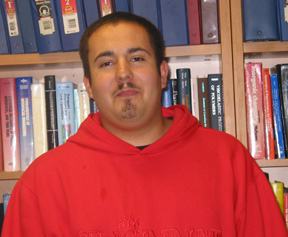
Home Institution: College of Menominee Nation
MRSEC Mentor: David Norris
Synthesis of Planar Synthetic Opals
Currently semi conductors are used in computer and communication networks. As this technology begins to reach its useful limit, photons are one possible future. This future technology will require a photonic material much the same way electronics sought the semi conductor. One possible solution is the photonic crystal, a synthetic crystal where the “atoms” are nearly one thousand times larger than in conventional crystals. Also of interest is the fact these solids are nanostructured on an optical length scale. Diffraction can cause the propagation of light to be modified within the material. Thus, photonic crystals hold great promise for revolutionizing the current electronics industry, possibly enabling optical integrated circuits. To fabricate photonic crystals we will follow a two step procedure. The first step involves formation of synthetic opals, which will be used as the template from which silicon inverse opals (photonic crystals) will be formed. We will prepare the template from silica spheres, these spheres are formed by reacting ethanol, water, ammonium hydroxide and tetraethylorthosilicate. The amount of each chemical controls the size of spheres obtained. We will explore these chemical combinations to improve the quality of the silica spheres. Through particle analysis the size of the spheres will be determined. The second step involves the actual formation of photonic crystals. A substrate is placed into the suspension of silica spheres. Under the proper conditions evaporation leads to deposition of an opal of uniform thickness.This material is the eventual goal of the project. The anticipated results from our methodology quite simply are a large quantity of high quality planar opals. These planar opals can then be used to create high quality inverse opals (photonic crystals). Our fellow researchers will then have enough raw materials to further their own experiments. Thus furthering the cause of photonics in future technology.

Home Institution: Penn State, Hazleton
MRSEC Mentor: Dan Frisbie/Mike Ward
Synthesis, Purification, and Characterization of New Crystalline Organic Semiconducting Materials
Functionalized derivatives of triphenodithiazine (TPDT), n-thiophene, and n-ethylenedioxythiophene (EDOT) will be synthesized, characterized, and tested in Thin Film Transistor (TFT) applications. Electronic applications involving TPDT are severely limited due to its insolubility in common organic solvents. To remedy this problem, a procedure to functionalize TPDT has been developed. It is believed that these functional groups will not only improve solubility, but increase uniformity in π-π stacking in the solid state. End substituted (and un-substituted) thiophene/EDOT oligomers will be more deeply investigated for their electronic properties. Oligo-thiophenes are especially versatile since the number of repeat units (n) can be modified through multi-step syntheses. By working with the Suzuki, Stille, Heck, and Grignard reactions, new novel thiophene compounds incorporating the EDOT molecule are anticipated to be produced.

Home Institution: University of St. Thomas
MRSEC Mentor: Dan Frisbie
Development of a Nanometer Scale Wire Using G-DNA
G-DNA is a quadruple helix composed of guanine tetrads called G-quartets, and is stabilized by metal cation coordination. The purpose of this study is to create a nanometer scale wire using G-DNA as a scaffold element. Tet1.5 [GGGGTTGGGG] and amino and thiol modified sequences will be allowed to self-assemble into long strands of G-DNA called G-wires. The G-wires will be doped with gold particles via biotin streptavidin interactions. The gold particles tethered to the G-wire scaffold will nucleate the deposition of silver particles, forming a nanometer scale wire. Atomic force microscopy, AFM, will provide images of the self-assembled nanoscale structures.
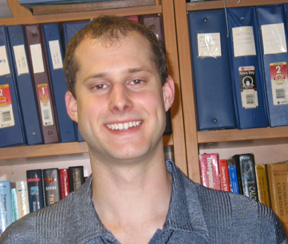
Home Institution: Augsburg College
MRSEC Mentor: Dan Dahlberg
Study of Fe/FeO bi-layers on MgO
Ferromagnetic (F) Fe and anti-ferromagnetic (AF) FeO layers were sputtered onto a magnesium oxide substrate to observe exchange bias in the Fe layer (F) caused by the FeO layer (AF). Different argon and oxygen pressures were used to produce various grades of FeO. Fe2O3 and Fe3O4 do not display the necessary AF behavior. Measurements with the VSM proved to be inconclusive due to limitations in temperature control and field strength. However, the magnitude of the magnetic moment given by the VSM combined with thickness calibration results do indicate the successful growth of the Fe/FeO bi-layer. Measurements are underway using the SQUID in an attempt to observe exchange bias in the bi-layer system.
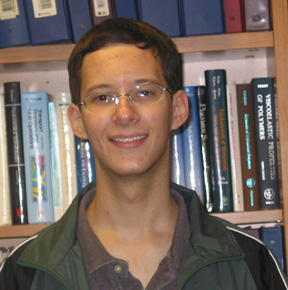
Home Institution: Harvey Mudd College
MRSEC Mentor: Dan Dahlberg
An Investigation of Exchange Interactions in AgMn Spin Glasses Using AC Susceptibility
We measure the vertical AC susceptibility of AgMn samples in the spinglass state and compare our results to those obtained by similar experiments on AFM-FM bilayers. The samples are cooled to 4.2 K in a vertical magnetic field. This field is turned off, and the vertical AC susceptibility is measured as a function of horizontal applied field. The observed behavior is similar to that seen in exchange-coupled AFM-FM bilayers.
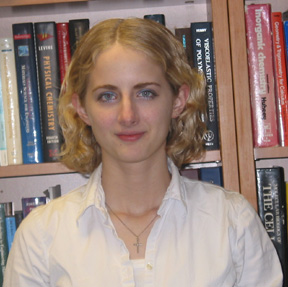
Home Institution: University of Wisconsin, Eau Claire
MRSEC Mentor: Chris Palmstrom
Interfacial Reactions and Determination of Diffusion Coefficients and Activation Energies of Thin Film Mn on GaAs(100)
Initial studies involved characterization of x-situ post-growth anneals of Al(50Å)/Mn(2000Å)/GaAs(100) structures at temperatures of 200-500ºC for 1-30 hours. X-ray Diffraction data for anneals above 200ºC, showed tetragonal Mn2As-like and MnGa-like phases. Rutherford Backscattering spectrometry measurements indicated the formulation of a diffusion controlled Mn0.6Ga0.2As0.2 reacted region. An Er marker layer between the GaAs and Mn layers, showed Mn to be the diffusive species. Once the value and nature of the diffusion coefficient was established, the activation energy of the n-Ga-As reaction was calculated. Knowledge of the activation energy, and thus diffusion rates, will allow for fabrication of Mn films on GaAs of known compositions and thicknesses at specific temperatures.
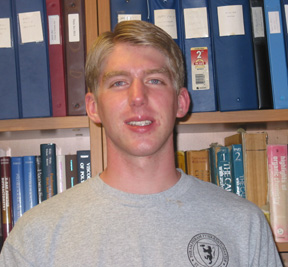
Home Institution: St. Olaf College
MRSEC Mentor: Dan Dahlberg
Magnetic Reversal In Nanoscopic Ellipsoidal Permalloy Dots
The direction of magnetization of nanoscopic ellipsoidal permalloy dots can theoretically be reversed using a combination of a DC magnetic fields lightly smaller than the coercive field and a magnetic pulsed field along the hard axis of the particle. I have examined the properties of the magnetic pulse necessary to cause magnetic reversal through simulations using LLG Micromagnetics Simulator software. I have also studied magnetic reversal experimentally using arrays of permalloy dots created using Electron Beam Lithography. Preliminary experimental results are inconclusive but suggest that magnetic reversal depends on the duration of the magnetic pulse. Understanding how to control the direction of magnetization of these particles could be applied to the development of MRAM.
UMN MRSEC
435 Amundson Hall, 421 Washington Ave. SE, Minneapolis, MN, 55455
P: 612-626-0713 | F: 612-626-7805